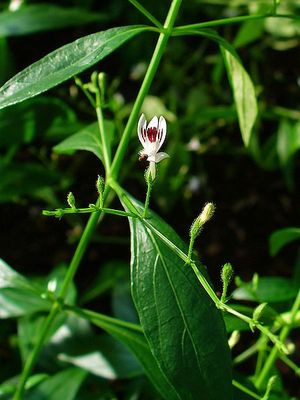You probably will not find andrographis (Andrographis paniculata) growing in the United States. You will instead have to travel to its native India or perhaps to gardens in China and Thailand. Also sometimes called kalmegh, meaning “king of the bitters,” andrographis has been used as a medicinal herb for centuries in both India’s Ayurvedic medicine and in Traditional Chinese Medicine. [See my overview on TCM.] Researchers around the world are finding that the traditional uses of andrographis have some validity and that there are also some promising future possibilities.
Indian physicians use bitter herbs — and andrographis is extremely bitter — to treat upset stomachs, improve digestion, and to increase the appetite. Andrographis was also traditionally used to treat jaundice, fevers, and even snakebite. The Chinese also used this herb to treat fevers, as well as, colds.
It turns out that andrographis is a good treatment for colds, flu, and sinus infections. It boosts the body’s immune system, enabling you to fight off colds and flu or, at the very least, to cause a shorter, milder version if contracted. Furthermore, additional studies done in the early 2000s indicated that when andrographis was combined with another herb eleuthero (Eleutherococcus senticosus), an herbal blend that is sold under the name of Kan Jang, to be even more effective than andrographis alone. In fact, it was found to be more effective than echinacea as a cold treatment for children. [For more information on the various studies conducted on andrographis, see: Health Library: Andrographis.] A study conducted by the Russians, also, discovered that people who were given andrographis recovered quicker from colds and flu than those who did not take the herb and that they were also less likely to develop other complications, such as bronchitis.
It also seems that andrographis’ ability to boost the immune system contributes to the validity of its traditional use as a treatment for stomach and intestinal disorders. Andrographis increases the number and activity of white blood cells, which attack the E.coli germs, as well as, the shigella germs that cause dysentery.
Other studies have shown that andrographis can restore the enzyme levels in livers in which these levels have been thrown out of whack by disease. In particular, it seems to be especially effective in combating damage caused y various carcinogens, parasites, and alcohol.
More recent studies indicate that andrographis might benefit diabetics. Apparently, it can help to lower blood sugar levels. [Note: These results are only preliminary, and more research is required.] This herb might also be able to reduce the blood clots that cause strokes and heart attacks.
Andrographis is generally safe; however, you should never take over the recommended dosage. For example, andrographis is frequently sold as a liquid extract. The dosage to boost your immunity is 1-2 teaspoons per day and 4 teaspoons per day when used as a treatment for colds and flu. I would recommend, however, that you look for the capsules instead. Andrographis tastes nasty. (It is a bitter herb after all.) Just be sure to follow the directions, which ever way you decide to take it. Too much can cause stomach upset, nausea, and vomiting.
Avoid andrographis if you are taking anticoagulant medication. Pregnant women and nursing mothers should not take this herb either. There are also some indications that andrographis can decrease fertility; therefore, couples trying to get pregnant should avoid it, as well. As with any herbal medicine, contact your primary healthcare professional and/or a certified herbalist before taking.
References:
Castleman, Michael. The New Healing Herbs. Emmaus, PA: Rodale Inc., 2009.
Health Library: Andrographis
